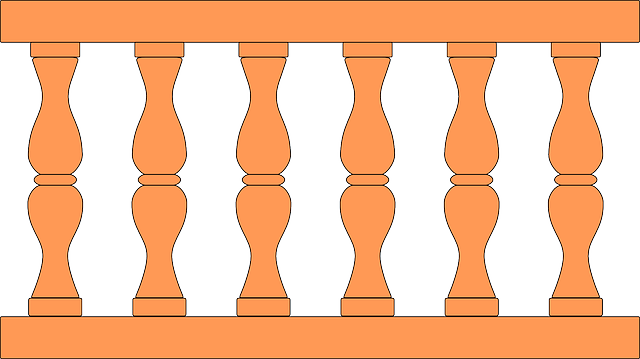In coastal regions, where harsh weather conditions and salt air pose unique challenges, selecting the right fencing material is paramount. Durable wooden fences offer an attractive and sustainable solution, providing both functional protection and aesthetic appeal. This article explores the intricacies of coastal fencing, from understanding environmental factors to choosing the ideal wood types and installation techniques. We delve into maintenance strategies to ensure longevity and discuss how these fences can enhance the unique character of coastal landscapes.
- Understanding Coastal Fencing Challenges
- Benefits of Durable Wooden Fencing
- Choosing the Right Wood Types
- Installation Considerations for Coastlines
- Maintenance Tips for Longevity
- Enhancing Coastal Aesthetics with Wooden Fences
Understanding Coastal Fencing Challenges
Coastal areas present unique challenges when it comes to fencing due to harsh weather conditions, such as high winds, salt mist, and regular exposure to extreme temperatures. Traditional fencing materials often struggle to withstand these elements, leading to frequent repairs or replacements. The key to durable coastal fencing lies in selecting materials that can resist corrosion, rot, and environmental damage while withstanding the force of strong coastal winds.
Wooden fences, when properly treated, can be an excellent choice for coastal properties. Treated timber has a higher resistance to moisture and salt, making it ideal for this environment. Additionally, modern treatment methods ensure the wood is sturdy enough to withstand high winds, providing a long-lasting and aesthetically pleasing solution for homeowners seeking privacy and security along the coast.
Benefits of Durable Wooden Fencing
Durable wooden fencing offers numerous advantages for coastal areas, where traditional materials might struggle against harsh conditions. Firstly, wood’s natural resistance to corrosion makes it an ideal choice for salt-prone environments, ensuring the fence remains strong and structurally sound over time. This longevity is a significant benefit, as it reduces the need for frequent replacements, saving both time and money in the long run.
Additionally, wooden fences can be aesthetically pleasing, providing a charming and natural look to any property. The warm tones and textures of wood complement coastal landscapes beautifully, allowing homeowners to enhance their outdoor spaces. Furthermore, with proper treatment and maintenance, these fences can withstand extreme weather events, offering reliable protection for properties while seamlessly integrating into the coastal aesthetic.
Choosing the Right Wood Types
When selecting wood for coastal fencing, understanding the local climate is key. Saltwater and high humidity levels can accelerate wood decay, so choosing rot-resistant species is essential. Redswood, known for its natural resistance to moisture and insects, is a popular choice due to its durability and aesthetic appeal. Cypress and Cedar are also renowned for their resilience against coastal conditions, making them suitable options for long-lasting fencing.
Considered the best in class, these wood types offer not only strength but also an attractive finish that can enhance the overall look of your property. It’s worth noting that while these woods start as naturally durable, proper treatment and maintenance are necessary to ensure their longevity against coastal elements.
Installation Considerations for Coastlines
When installing durable wooden fencing in coastal areas, several unique considerations come into play due to the harsh marine environment. First, it’s crucial to choose fence materials that can withstand salt spray and moisture, which can accelerate wood decay. Treated timber or specific types of composite materials designed for outdoor durability are ideal choices. The installation process should involve proper grounding to prevent lightning damage, a common concern along coastlines.
Additionally, the location of the fence in relation to high-tide lines and potential storm surges is critical. Installing the fence higher than expected water levels ensures it remains intact during severe weather events. Proper drainage systems should also be integrated into the design to prevent water accumulation behind the fence, which could compromise its structural integrity over time.
Maintenance Tips for Longevity
To ensure your durable wooden fencing stands the test of time in coastal areas, regular maintenance is key. Start by cleaning the fence twice a year to remove salt spray and other debris that can accelerate wood decay. Use a soft-bristled brush and mild detergent for this task.
After cleaning, apply a fresh coat of high-quality water-repellent sealer or stain every 1-2 years. This protective layer shields the wood from moisture and UV radiation, which are prevalent in coastal environments. Keep an eye out for any damaged or loose boards and promptly replace them to prevent water infiltration and structural compromise. Regular inspection will help catch issues early, ensuring your fencing remains sturdy and long-lasting.
Enhancing Coastal Aesthetics with Wooden Fences
Wooden fences have long been a beloved feature in many landscapes, and coastal areas are no exception. When tastefully designed and installed, they can enhance the natural beauty of shorelines, beaches, and seaside homes. The organic look of wood blends seamlessly with the coastal environment, creating a harmonious aesthetic that’s both inviting and picturesque. A well-chosen wooden fence can serve as a backdrop to stunning ocean views, providing privacy while complementing the region’s unique character.
Whether it’s a classic split-rail fence meandering along a beachfront or a modern vertical wood panel system, these structures offer more than just visual appeal. They provide a sense of security and protection against coastal elements like wind and salt spray. The durability of high-quality wooden fencing ensures that these features can withstand the test of time and harsh marine environments, making them an excellent investment for property owners looking to enhance their coastal abode’s curb appeal.
